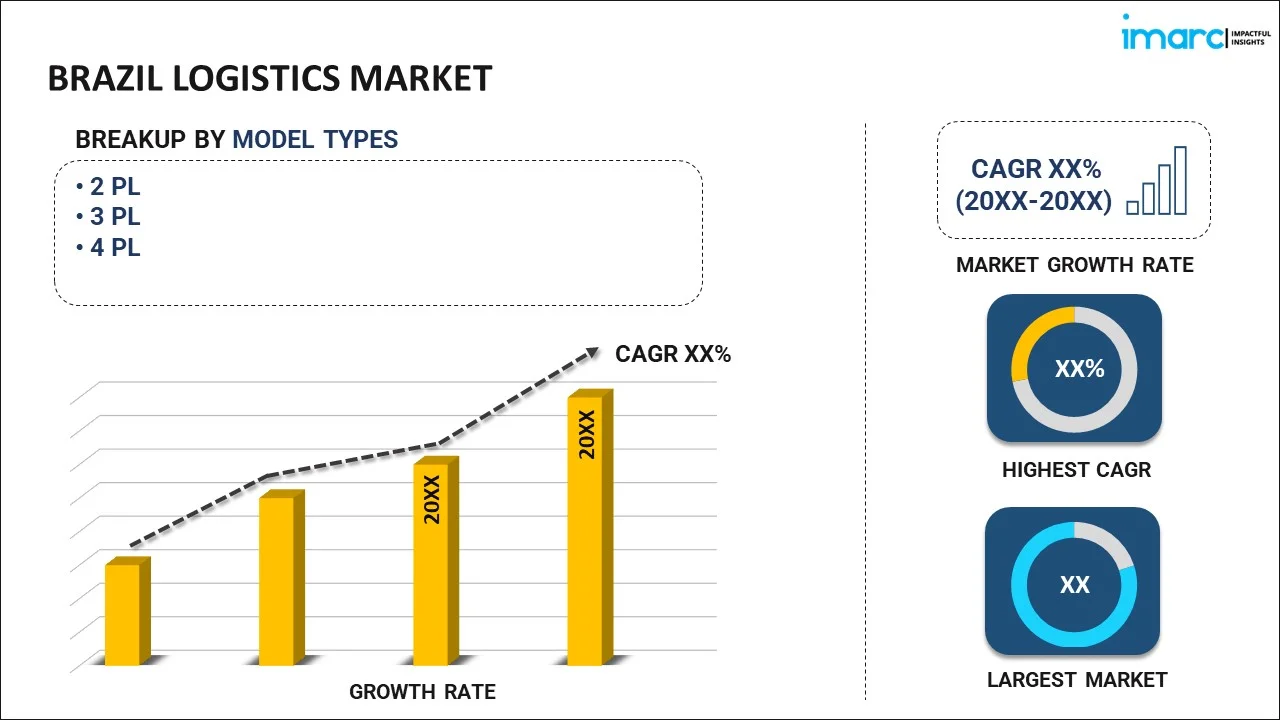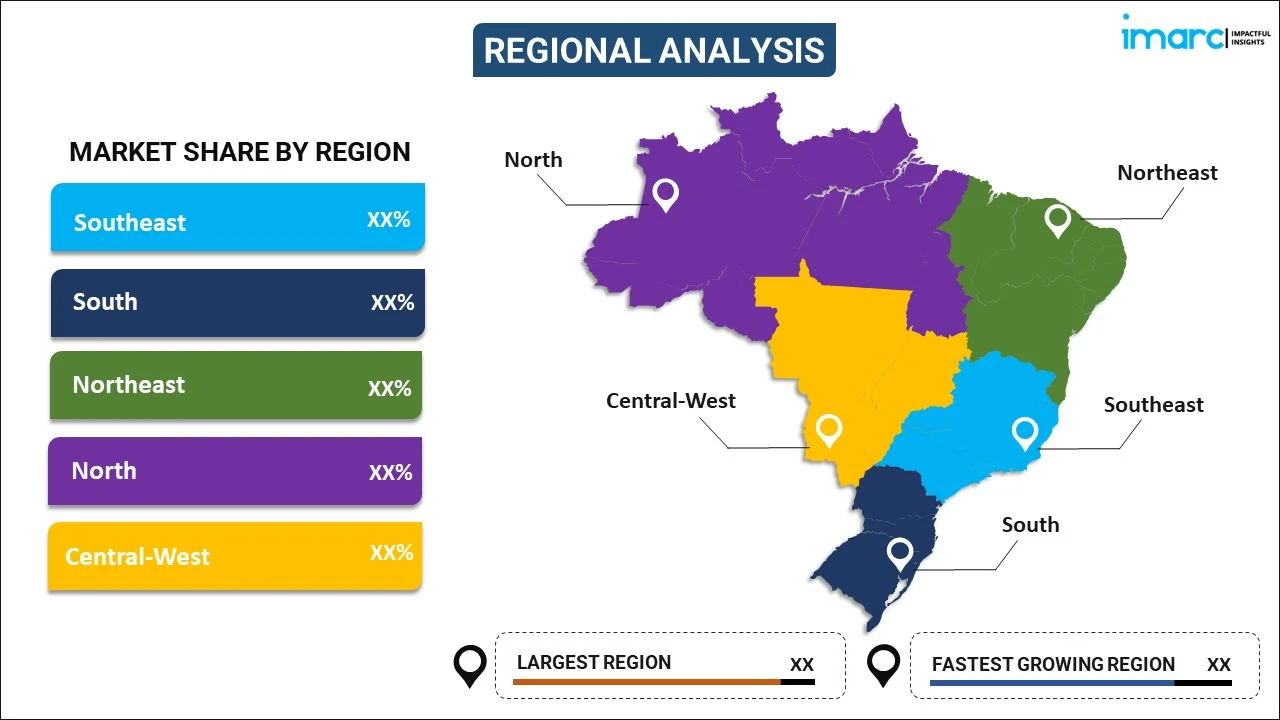
Brazil Logistics Market Size Report by Model Type (2 PL, 3 PL, 4 PL), Transportation Mode (Roadways, Seaways, Railways, Airways), End Use (Manufacturing, Consumer Goods, Retail, Food and Beverages, IT Hardware, Healthcare, Chemicals, Construction, Automotive, Telecom, Oil and Gas, and Others), and Region 2026-2034
Market Overview:
Brazil logistics market size reached USD 127.0 Billion in 2025. Looking forward, IMARC Group expects the market to reach USD 176.7 Billion by 2034, exhibiting a growth rate (CAGR) of 3.74% during 2026-2034. The country's role in global production networks, the rising foreign direct investment, the growing customs reforms, the focus on sustainable practices and environmentally friendly logistics solutions, and the rapid urbanization are some of the factors propelling the market.
|
Report Attribute
|
Key Statistics
|
|---|---|
|
Base Year
|
2025
|
|
Forecast Years
|
2026-2034
|
|
Historical Years
|
2020-2025
|
|
Market Size in 2025
|
USD 127.0 Billion |
|
Market Forecast in 2034
|
USD 176.7 Billion |
| Market Growth Rate 2026-2034 | 3.74% |
Logistics is the intricate web of activities involved in the efficient and effective flow of goods, services, and information from the point of origin to the point of consumption. It's the art and science of managing and coordinating the various processes that contribute to the movement and storage of resources. From procurement and production to transportation and distribution, logistics encompasses a broad spectrum of functions crucial to ensuring products reach their destination seamlessly. At its core, logistics seeks to optimize supply chain operations, minimizing costs and maximizing efficiency. This involves meticulous planning, organization, and execution. Inventory management, transportation planning, warehouse optimization, and information coordination are key facets of logistics management. In a globalized world, logistics plays a pivotal role in connecting manufacturers with consumers across different geographical locations. It's not merely about moving goods; it's about doing so in the most timely, cost-effective, and environmentally sustainable manner. Technologies like GPS tracking, RFID systems, and advanced analytics have become integral in enhancing logistics operations, providing real-time visibility and data-driven decision-making. Whether it's the timely delivery of raw materials to a production facility or ensuring products reach end-users promptly, logistics acts as the backbone of supply chain management. Efficient logistics contribute not only to economic competitiveness but also to customer satisfaction. In essence, logistics is the invisible force that keeps the wheels of commerce turning, seamlessly orchestrating the complex dance of resources across the global marketplace.
Brazil Logistics Market Trends:
The market in Brazil is majorly driven by the expanding economy. This fosters increased trade activities both domestically and internationally. The nation's diverse and resource-rich economy has led to a rise in demand for efficient logistics services as businesses expand their operations, necessitating a robust supply chain infrastructure to meet the burgeoning requirements. Furthermore, the growth of e-commerce has emerged as a powerful catalyst for the logistics sector in Brazil. The widespread adoption of online shopping platforms has triggered a surge in the movement of goods, compelling logistics providers to adapt and innovate to cope with the escalating demand. E-commerce companies, in particular, are relying on sophisticated logistics solutions to ensure swift and reliable deliveries, driving the expansion of the market. Moreover, the escalating infrastructure development is propelling the market. The government's commitment to extensive infrastructure projects, including improvements in transport networks and ports, has a direct impact on the efficiency of logistics operations. Enhanced infrastructure not only reduces transportation costs but also contributes to streamlined logistics processes, fostering overall growth in the market. Besides, the country's ideal geographical location as a key player in global trade further fuels the growth of its logistics market. The country's position as a major participant in international trade has attracted businesses seeking to tap into the South American market. This influx of global trade has intensified the need for well-established logistics networks, positioning Brazil as a critical hub for the movement of goods across borders. Technological advancements are reshaping the landscape of Brazil's logistics sector. The integration of automation, data analytics, and artificial intelligence has become instrumental in optimizing supply chain processes. Logistics providers leveraging these technologies not only enhance operational efficiency but also offer more agile and responsive services, aligning with the evolving demands of businesses and consumers in Brazil. Additionally, the government initiatives and policies further underscore the favorable conditions propelling the logistics market in Brazil. Regulatory reforms, trade facilitation measures, and incentives to attract investments in logistics infrastructure are creating an environment conducive to sectoral growth. This support from the government reinforces the overall resilience and attractiveness of Brazil's logistics market, positioning it for sustained expansion and providing opportunities for both domestic and international players.
Brazil Logistics Market Segmentation:
IMARC Group provides an analysis of the key trends in each segment of the market, along with forecasts at the country level for 2026-2034. Our report has categorized the market based on model type, transportation mode, and end use.
Model Type Insights:

- 2 PL
- 3 PL
- 4 PL
The report has provided a detailed breakup and analysis of the market based on the model type. This includes 2 PL, 3 PL, and 4 PL.
Transportation Mode Insights:
- Roadways
- Seaways
- Railways
- Airways
A detailed breakup and analysis of the market based on the transportation mode have also been provided in the report. This includes roadways, seaways, railways, and airways.
End Use Insights:
- Manufacturing
- Consumer Goods
- Retail
- Food and Beverages
- IT Hardware
- Healthcare
- Chemicals
- Construction
- Automotive
- Telecom
- Oil and Gas
- Others
The report has provided a detailed breakup and analysis of the market based on the end use. This includes manufacturing, consumer goods, retail, food and beverages, IT hardware, healthcare, chemicals, construction, automotive, telecom, oil and gas, and others.
Regional Insights:

- Southeast
- South
- Northeast
- North
- Central-West
The report has also provided a comprehensive analysis of all the major regional markets, which include Southeast, South, Northeast, North, and Central-West.
Competitive Landscape:
The market research report has also provided a comprehensive analysis of the competitive landscape in the market. Competitive analysis such as market structure, key player positioning, top winning strategies, competitive dashboard, and company evaluation quadrant has been covered in the report. Also, detailed profiles of all major companies have been provided.
Brazil Logistics Market Report Coverage:
| Report Features | Details |
|---|---|
| Base Year of the Analysis | 2025 |
| Historical Period | 2020-2025 |
| Forecast Period | 2026-2034 |
| Units | Billion USD |
| Scope of the Report | Exploration of Historical and Forecast Trends, Industry Catalysts and Challenges, Segment-Wise Historical and Predictive Market Assessment:
|
| Model Types Covered | 2 PL, 3 PL, 4 PL |
| Transportation Modes Covered | Roadways, Seaways, Railways, Airways |
| End Uses Covered | Manufacturing, Consumer Goods, Retail, Food and Beverages, IT Hardware, Healthcare, Chemicals, Construction, Automotive, Telecom, Oil and Gas, Others |
| Regions Covered | Southeast, South, Northeast, North, Central-West |
| Customization Scope | 10% Free Customization |
| Post-Sale Analyst Support | 10-12 Weeks |
| Delivery Format | PDF and Excel through Email (We can also provide the editable version of the report in PPT/Word format on special request) |
Key Questions Answered in This Report:
- How has the Brazil logistics market performed so far and how will it perform in the coming years?
- What is the breakup of the Brazil logistics market on the basis of model type?
- What is the breakup of the Brazil logistics market on the basis of transportation mode?
- What is the breakup of the Brazil logistics market on the basis of end use?
- What are the various stages in the value chain of the Brazil logistics market?
- What are the key driving factors and challenges in the Brazil logistics?
- What is the structure of the Brazil logistics market and who are the key players?
- What is the degree of competition in the Brazil logistics market?
Key Benefits for Stakeholders:
- IMARC’s industry report offers a comprehensive quantitative analysis of various market segments, historical and current market trends, market forecasts, and dynamics of the Brazil logistics market from 2020-2034.
- The research report provides the latest information on the market drivers, challenges, and opportunities in the Brazil logistics market.
- Porter's five forces analysis assist stakeholders in assessing the impact of new entrants, competitive rivalry, supplier power, buyer power, and the threat of substitution. It helps stakeholders to analyze the level of competition within the Brazil logistics industry and its attractiveness.
- Competitive landscape allows stakeholders to understand their competitive environment and provides an insight into the current positions of key players in the market.
Need more help?
- Speak to our experienced analysts for insights on the current market scenarios.
- Include additional segments and countries to customize the report as per your requirement.
- Gain an unparalleled competitive advantage in your domain by understanding how to utilize the report and positively impacting your operations and revenue.
- For further assistance, please connect with our analysts.
 Request Customization
Request Customization
 Speak to an Analyst
Speak to an Analyst
 Request Brochure
Request Brochure
 Inquire Before Buying
Inquire Before Buying




.webp)




.webp)












